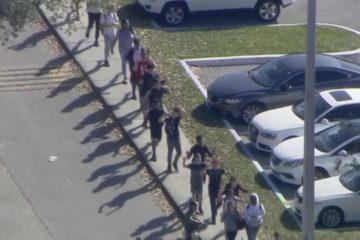Terrorists With Assault Weapons Rewrite the Script: Noah Feldman

©2015 Bloomberg View
O00XSN6S9728
O00XSN6S9728
(Bloomberg View) — Over the last 15 years, Americans have become accustomed to distinguishing domestic mass shootings from Islamic terrorism — the difference between Columbine and the Sept. 11 attacks, if you will. In 2015, that conceptual division broke down with the massacre in San Bernardino, California. It wasn’t the first domestic act of terrorism inspired by Islam — Army Major Nidal Hasan’s attack on Fort Hood and the Boston Marathon bombing both featured American Muslim terrorists. But San Bernardino was the first time the two paradigms were literally indistinguishable. It’s as if the terrorists finally said, “Who needs airplanes when assault weapons are readily available?”
QuickTakeGuns in America
Why does the 2015 breakdown of the Columbine-9/11 distinction matter? The answer has everything to do with whether Americans ultimately decide to accept or reject the contemporary realities of terrorism.
Until now, the responses to the two kinds of attacks have diverged radically.
The national reaction to Columbine-style shooting attacks has become highly stylized and predictable: We cry, liberals call for tougher gun laws and nothing happens. The shooting in Newtown, Connecticut, is the perfect exemplar, as gun critics insisted that the death of so many young children would surely drive change, and gun-rights supporters said that if anything, the tragedy showed the need for more guns. President Barack Obama has gone from showing genuine outrage about congressional inaction in the aftermath of Newtown to something that looks much more like saddened resignation in the wake of San Bernardino.
In contrast, Americans’ typical response to Islamic terrorism is to call for action — and the government typically responds. The Sept. 11 attacks brought a host of air-safety reforms, not to mention the Afghanistan war. The U.S. has doubled down on bombing Islamic State when attacks are traceable to that organization. Intelligence agencies scrutinize Muslim Americans, with a focus that may be misplaced but reflects an unwillingness to treat Islamic terrorism as a new normal.
The San Bernardino attack may mark the inflection point where the Columbine response and the 9/11 response go head to head. Terrorists are, it turns out, just as able to buy and use assault weapons as other shooters. If Americans were to follow the 9/11 paradigm, this would mean regulating gun sales to try to avoid repetition.
And that regulation would logically target all purchasers, not just those on the spotty and incomplete no-fly list. The involvement of Enrique Marquez, the friend and neighbor of Syed Rizwan Farook who police say helped plan and prepare the San Bernardino attack, shows that it wouldn’t be effective to scrutinize Muslims’ gun purchases, even if it were constitutional, which it isn’t.
But the National Rifle Association shows no inclination to soften its stance on assault weapons, notwithstanding the 9/11 paradigm. And given the political economy of the gun-rights movement, it seems unlikely that San Bernardino would give gun reformers leverage that they failed to achieve even after Newtown.
That leaves the other alternative: applying the Columbine paradigm to domestic Islamic terror. What, after all, can be done to discourage assault-weapon attacks by domestic Muslim terrorists if nothing can be done to prevent them from acquiring the weapons? The answer is the same as the Columbine answer: nothing can be done, so Americans accept the attacks as normal.
Until 2015, most Americans — and I include myself — didn’t realize that gun attacks occur on average once per day. That statistic is striking not because it means we’re in constant fear, but precisely because we aren’t. Columbine attacks are our new normal — why shouldn’t Islamic terror attacks be part of the same normality?
Before you say that this notion is intolerable, pause to consider that other Western countries have managed to normalize terrorism. Britain suffered IRA attacks for years, and the normalization robbed them to an extent of their leverage. Israel has institutionalized its own responses to terrorism, for better or worse. Israelis can’t tolerate huge attacks regularly, but they mostly accept some baseline level of terror as part of the price of remaining in the West Bank.
There’s nothing appealing about these examples — but they exist, and there’s no reason the U.S. should be exempt from them. Perhaps we will simply begin to fear Islamic terrorism less, at the level at which we fear random mass shootings. If so, 2015 will have marked the turning point. We’ll be a little less safe, but also perhaps a little less likely to invade or bomb others in response to events at home.
According to some reports, the San Bernardino attackers were inspired by an al-Qaeda propagandist, the American Anwar al-Awlaki. But you know what? The U.S. already killed Awlaki in a drone strike in 2011. What are we going to do, kill him again? Welcome to the new normal, where mass shootings and terrorist attacks aren’t so different after all.This column does not necessarily reflect the opinion of the editorial board or Bloomberg LP and its owners.
QuickTakeGuns in America
Why does the 2015 breakdown of the Columbine-9/11 distinction matter? The answer has everything to do with whether Americans ultimately decide to accept or reject the contemporary realities of terrorism.
Until now, the responses to the two kinds of attacks have diverged radically.
The national reaction to Columbine-style shooting attacks has become highly stylized and predictable: We cry, liberals call for tougher gun laws and nothing happens. The shooting in Newtown, Connecticut, is the perfect exemplar, as gun critics insisted that the death of so many young children would surely drive change, and gun-rights supporters said that if anything, the tragedy showed the need for more guns. President Barack Obama has gone from showing genuine outrage about congressional inaction in the aftermath of Newtown to something that looks much more like saddened resignation in the wake of San Bernardino.
In contrast, Americans’ typical response to Islamic terrorism is to call for action — and the government typically responds. The Sept. 11 attacks brought a host of air-safety reforms, not to mention the Afghanistan war. The U.S. has doubled down on bombing Islamic State when attacks are traceable to that organization. Intelligence agencies scrutinize Muslim Americans, with a focus that may be misplaced but reflects an unwillingness to treat Islamic terrorism as a new normal.
The San Bernardino attack may mark the inflection point where the Columbine response and the 9/11 response go head to head. Terrorists are, it turns out, just as able to buy and use assault weapons as other shooters. If Americans were to follow the 9/11 paradigm, this would mean regulating gun sales to try to avoid repetition.
And that regulation would logically target all purchasers, not just those on the spotty and incomplete no-fly list. The involvement of Enrique Marquez, the friend and neighbor of Syed Rizwan Farook who police say helped plan and prepare the San Bernardino attack, shows that it wouldn’t be effective to scrutinize Muslims’ gun purchases, even if it were constitutional, which it isn’t.
But the National Rifle Association shows no inclination to soften its stance on assault weapons, notwithstanding the 9/11 paradigm. And given the political economy of the gun-rights movement, it seems unlikely that San Bernardino would give gun reformers leverage that they failed to achieve even after Newtown.
That leaves the other alternative: applying the Columbine paradigm to domestic Islamic terror. What, after all, can be done to discourage assault-weapon attacks by domestic Muslim terrorists if nothing can be done to prevent them from acquiring the weapons? The answer is the same as the Columbine answer: nothing can be done, so Americans accept the attacks as normal.
Until 2015, most Americans — and I include myself — didn’t realize that gun attacks occur on average once per day. That statistic is striking not because it means we’re in constant fear, but precisely because we aren’t. Columbine attacks are our new normal — why shouldn’t Islamic terror attacks be part of the same normality?
Before you say that this notion is intolerable, pause to consider that other Western countries have managed to normalize terrorism. Britain suffered IRA attacks for years, and the normalization robbed them to an extent of their leverage. Israel has institutionalized its own responses to terrorism, for better or worse. Israelis can’t tolerate huge attacks regularly, but they mostly accept some baseline level of terror as part of the price of remaining in the West Bank.
There’s nothing appealing about these examples — but they exist, and there’s no reason the U.S. should be exempt from them. Perhaps we will simply begin to fear Islamic terrorism less, at the level at which we fear random mass shootings. If so, 2015 will have marked the turning point. We’ll be a little less safe, but also perhaps a little less likely to invade or bomb others in response to events at home.
According to some reports, the San Bernardino attackers were inspired by an al-Qaeda propagandist, the American Anwar al-Awlaki. But you know what? The U.S. already killed Awlaki in a drone strike in 2011. What are we going to do, kill him again? Welcome to the new normal, where mass shootings and terrorist attacks aren’t so different after all.This column does not necessarily reflect the opinion of the editorial board or Bloomberg LP and its owners.
To contact the author of this story: Noah Feldman at nfeldman7@bloomberg.net To contact the editor responsible for this story: Stacey Shick at sshick@bloomberg.net
For more columns from Bloomberg View, visit http://www.bloomberg.com/view
For more columns from Bloomberg View, visit http://www.bloomberg.com/view






No Comment